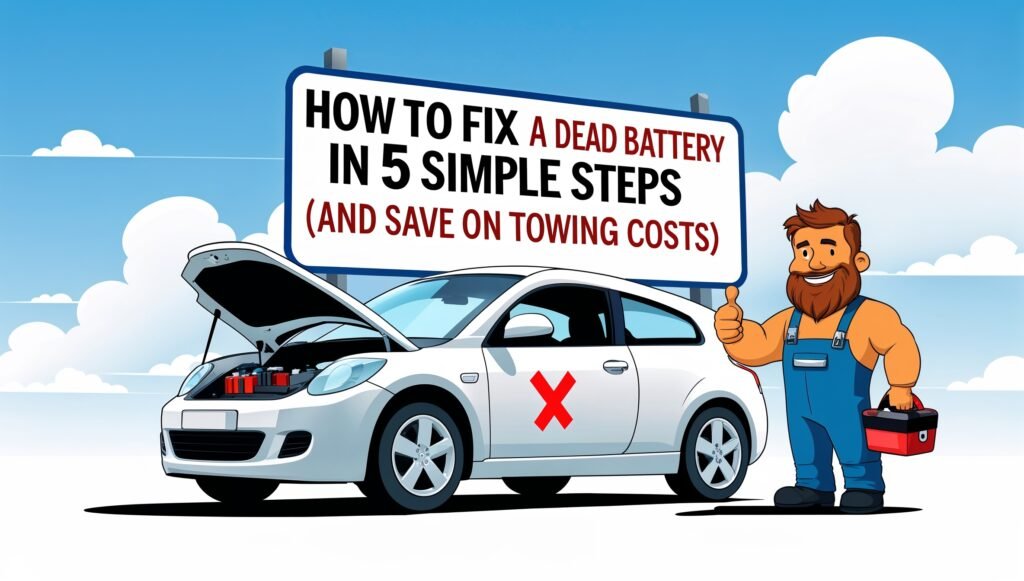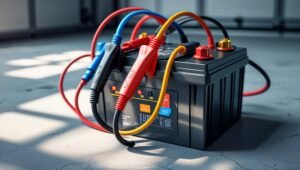
A dead battery is one of the most common reasons your car won’t start, and it’s something that can happen to anyone. The good news is that fixing a dead battery is easier than you might think, and it can save you from costly towing bills or expensive mechanic visits. In this blog, we’ll show you how to fix a dead battery in 5 simple steps, helping you get back on the road without breaking the bank.
Why Does a Car Battery Die?
There are several reasons your car battery might die. It could be because of extreme weather, an old battery, or leaving your lights on for too long. Regardless of the reason, a dead battery is a hassle — especially when you’re stuck on the side of the road or in a parking lot.
But before you panic, remember that many car owners can fix their own dead batteries without professional help. By following a few easy steps, you can save both time and money.

Step 1: Check the Battery and look for Obvious Problems
Before attempting any repairs, it’s important to inspect your battery. Start by checking the battery terminals for corrosion or loose connections. If you notice any corrosion (a white, powdery substance around the terminals), this could be the reason your battery is not working properly. You can clean the corrosion with a mixture of baking soda and water, which will help improve the connection.
Also, ensure that the battery cables are securely connected to the battery posts. A loose connection can prevent your car from starting, even if the battery is in good condition.
Step 2: Use Jumper Cables to Jump-Start the Battery
If the battery seems to be in good condition but just needs a jump, you can use jumper cables and another car to get it started. Here’s how:
Park the cars close together: Position the working car so that the jumper cables can easily reach both batteries.
Turn off both cars: Ensure that both cars are off before connecting the cables.
Connect the jumper cables: Attach one red clip to the positive terminal of the dead battery and the other red clip to the positive terminal of the working battery. Then, attach the black clip to the negative terminal of the working battery and the other black clip to an unpainted metal surface (like a bolt) on the car with the dead battery.
Start the working car: Let it run for a few minutes before attempting to start the car with the dead battery.
Start your car: After a few minutes, try starting your car with the dead battery. If it starts, leave both cars running for a few minutes to recharge the battery.

Step 3: Drive Your Car to Recharge the Battery
Once your car starts, it’s important to drive it for at least 15-30 minutes to allow the alternator to recharge the battery. Don’t rely on just idling your car; driving it ensures that the alternator is working to replenish the charge.
If you’re unable to drive immediately, consider turning on the car and letting it run for a while to charge the battery. However, driving is more effective for ensuring that your battery gets a full charge.
Step 4: Consider Using a Battery Charger
If jump-starting the car doesn’t work or you don’t have access to jumper cables, use a battery charger. This tool can recharge the dead battery with no other car. Here’s how to use a battery charger:
Read the charger’s manual: Before using the charger, make sure you understand how it works. Some chargers require you to disconnect the battery from the car, while others can charge it while it’s still connected.
Connect the charger: Just like you did with the jumper cables, connect the red clamp to the positive terminal and the black clamp to the negative terminal.
Set the charger: Set the charger to the voltage for your battery (usually 12V for most cars).
Charge the battery: Let the charger do its work. Depending on the battery’s charge level, this process could take a few hours.

Step 5: Replace the Battery if necessary
If none of the above steps work and your car still won’t start, it might be time to replace your battery. Batteries typically last between 3-5 years, so if your battery is older than that, it might be time for a new one.
When buying a replacement, be sure to select the right type of battery for your car. You can easily find this information in your car’s manual or by checking online. While buying a new battery can be an investment, it’s a lot cheaper than paying for a tow truck and a mechanic’s labor costs.
How to Prevent Your Battery from Dying in the Future
Now that your car is up and running, there are a few ways to prevent future battery issues:
Regular Maintenance: Have your battery checked regularly by a professional, especially before long trips or during extreme weather.
Keep the Terminals Clean: Regularly clean the battery terminals to avoid corrosion, which can cause the battery to fail.
Turn Off Electrical Systems: Always remember to turn off lights, radio, and other electrical systems when you’re not using them, as they can drain the battery.
By following these steps, you can keep your battery in good condition and prevent future problems from arising.
Need More Car Maintenance Tips? Check Out Our DIY Guides.
For more DIY tips on car maintenance, be sure to check out our Complete Car Repair Guide. This guide covers everything from battery issues to engine problems, giving you all the information you need to keep your car running smoothly. Plus, we offer step-by-step instructions that make car repairs easy and affordable.
If you’re interested in learning more about how to save money on car repairs, consider purchasing our DIY Car Maintenance Ebook, which includes a comprehensive guide to keeping your car in top shape with no expensive mechanic visits.
Finally
A dead battery doesn’t have to be a costly or frustrating issue. By following these five simple steps, you can fix your battery, avoid the need for towing services, and save yourself money. Whether your jump-starting your car or recharging it with a battery charger, there are easy and affordable solutions to get your car back on the road. Remember to stay proactive about battery maintenance to prevent future issues.
For more helpful car repair tips and guides, visit FixItSmartly.com today!
Step 1: Check the Battery and look for Obvious Problems
Before attempting any repairs, it’s important to inspect your battery. Start by checking the battery terminals for corrosion or loose connections. If you notice any corrosion (a white, powdery substance around the terminals), this could be the reason your battery is not working properly. You can clean the corrosion with a mixture of baking soda and water, which will help improve the connection.
Also, ensure that the battery cables are securely connected to the battery posts. A loose connection can prevent your car from starting, even if the battery is in good condition.
Step 2: Use Jumper Cables to Jump-Start the Battery
If the battery seems to be in good condition but just needs a jump, you can use jumper cables and another car to get it started. Here’s how:
Park the cars close together: Position the working car so that the jumper cables can easily reach both batteries.
Turn off both cars: Ensure that both cars are off before connecting the cables.
Connect the jumper cables: Attach one red clip to the positive terminal of the dead battery and the other red clip to the positive terminal of the working battery. Then, attach the black clip to the negative terminal of the working battery and the other black clip to an unpainted metal surface (like a bolt) on the car with the dead battery.
Start the working car: Let it run for a few minutes before attempting to start the car with the dead battery.
Start your car: After a few minutes, try starting your car with the dead battery. If it starts, leave both cars running for a few minutes to recharge the battery.
[Insert Image Here: A picture of jumper cables being connected to the car battery]
Step 3: Drive Your Car to Recharge the Battery
Once your car starts, it’s important to drive it for at least 15-30 minutes to allow the alternator to recharge the battery. Don’t rely on just idling your car; driving it ensures that the alternator is working to replenish the charge.
If you’re unable to drive immediately, consider turning on the car and letting it run for a while to charge the battery. However, driving is more effective for ensuring that your battery gets a full charge.
Step 4: Consider Using a Battery Charger
If jump-starting the car doesn’t work or you don’t have access to jumper cables, use a battery charger. This tool can recharge the dead battery with no other car. Here’s how to use a battery charger:
Read the charger’s manual: Before using the charger, make sure you understand how it works. Some chargers require you to disconnect the battery from the car, while others can charge it while it’s still connected.
Connect the charger: Just like you did with the jumper cables, connect the red clamp to the positive terminal and the black clamp to the negative terminal.
Set the charger: Set the charger to the voltage for your battery (usually 12V for most cars).
Charge the battery: Let the charger do its work. Depending on the battery’s charge level, this process could take a few hours.
[Insert Image Here: A picture of a battery charger connected to a car battery]
Step 5: Replace the Battery if necessary
If none of the above steps work and your car still won’t start, it might be time to replace your battery. Batteries typically last between 3-5 years, so if your battery is older than that, it might be time for a new one.
When buying a replacement, be sure to select the right type of battery for your car. You can easily find this information in your car’s manual or by checking online. While buying a new battery can be an investment, it’s a lot cheaper than paying for a tow truck and a mechanic’s labor costs.
How to Prevent Your Battery from Dying in the Future
Now that your car is up and running, there are a few ways to prevent future battery issues:
Regular Maintenance: Have your battery checked regularly by a professional, especially before long trips or during extreme weather.
Keep the Terminals Clean: Regularly clean the battery terminals to avoid corrosion, which can cause the battery to fail.
Turn Off Electrical Systems: Always remember to turn off lights, radio, and other electrical systems when you’re not using them, as they can drain the battery.
By following these steps, you can keep your battery in good condition and prevent future problems from arising.
Need More Car Maintenance Tips? Check Out Our DIY Guides.
For more DIY tips on car maintenance, be sure to check out our Complete Car Repair Guide. This guide covers everything from battery issues to engine problems, giving you all the information you need to keep your car running smoothly. Plus, we offer step-by-step instructions that make car repairs easy and affordable.
If you’re interested in learning more about how to save money on car repairs, consider purchasing our DIY Car Maintenance Ebook, which includes a comprehensive guide to keeping your car in top shape with no expensive mechanic visits.
Finally
A dead battery doesn’t have to be a costly or frustrating issue. By following these five simple steps, you can fix your battery, avoid the need for towing services, and save yourself money. Whether your jump-starting your car or recharging it with a battery charger, there are easy and affordable solutions to get your car back on the road. Remember to stay proactive about battery maintenance to prevent future issues.
For more helpful car repair tips and guides, visit FixItSmartly.com today!
FixItSmartly.com helps everyday people save money and build confidence by tackling home and car repairs with easy, practical DIY solutions. Live smart, safe, and self-reliant — one fix at a time.
Copyright © 2025 Fixitsmartly